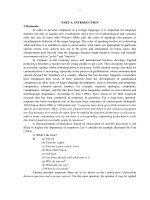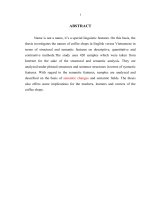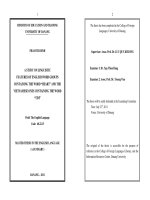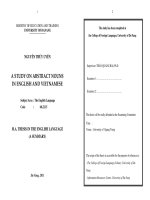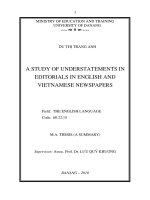Short term memory in english to vietnamese consecutive interpreting
Bạn đang xem bản rút gọn của tài liệu. Xem và tải ngay bản đầy đủ của tài liệu tại đây (460.02 KB, 62 trang )
BỘ GIÁO DỤC VÀ ĐÀO TẠO
TRƯỜNG ĐẠI HỌC DÂN LẬP HẢI PHỊNG
-------------------------------
KHĨA LUẬN TỐT NGHIỆP
NGÀNH: NGOẠI NGỮ
Sinh viên
: Hồng Thị Thanh Vân
Giảng viên hướng dẫn : Th.s Đào Thị Lan Hương
HẢI PHÒNG - 2013
BỘ GIÁO DỤC VÀ ĐÀO TẠO
TRƯỜNG ĐẠI HỌC DÂN LẬP HẢI PHỊNG
-----------------------------------
SHORT-TERM MEMORY IN ENGLISH TO
VIETNAMESE CONSECUTIVE
INTERPRETING
KHĨA LUẬN TỐT NGHIỆP ĐẠI HỌC HỆ CHÍNH QUY
NGÀNH: NGOẠI NGỮ
Sinh viên
: Hồng Thị Thanh Vân
Lớp
: NA1301
Giảng viên hướng dẫn : Th.s Đào Thị Lan Hương
HẢI PHÒNG – 2013
BỘ GIÁO DỤC VÀ ĐÀO TẠO
TRƯỜNG ĐẠI HỌC DÂN LẬP HẢI PHÒNG
--------------------------------------
NHIỆM VỤ ĐỀ TÀI TỐT NGHIỆP
Sinh viên: ............................................................Mã SV:............................
Lớp: .............................Ngành:....................................................................
Tên đề tài: .................................................................................................
..................................................................................................
.................................................................................................
..................................................................................................
NHIỆM VỤ ĐỀ TÀI
1. Nội dung và các yêu cầu cần giải quyết trong nhiệm vụ đề tài tốt
nghiệp
( về lý luận, thực tiễn, các số liệu cần tính tốn và các bản vẽ).
……………………………………………………………………………..
……………………………………………………………………………..
……………………………………………………………………………..
……………………………………………………………………………..
……………………………………………………………………………..
……………………………………………………………………………..
……………………………………………………………………………..
2. Các số liệu cần thiết để thiết kế, tính tốn.
……………………………………………………………………………..
……………………………………………………………………………..
……………………………………………………………………………..
……………………………………………………………………………..
……………………………………………………………………………..
……………………………………………………………………………..
……………………………………………………………………………..
3. Địa điểm thực tập tốt nghiệp.
……………………………………………………………………………..
……………………………………………………………………………..
……………………………………………………………………………..
CÁN BỘ HƯỚNG DẪN ĐỀ TÀI TỐT NGHIỆP
Người hướng dẫn thứ nhất:
Họ và tên:.............................................................................................
Học hàm, học vị:...................................................................................
Cơ quan công tác:.................................................................................
Nội dung hướng dẫn:............................................................................
Người hướng dẫn thứ hai:
Họ và tên:.............................................................................................
Học hàm, học vị:...................................................................................
Cơ quan công tác:.................................................................................
Nội dung hướng dẫn:............................................................................
Đề tài tốt nghiệp được giao ngày 25 tháng 03 năm 2013
Yêu cầu phải hoàn thành xong trước ngày 29 tháng 06 năm 2013
Đã nhận nhiệm vụ ĐTTN
Đã giao nhiệm vụ ĐTTN
Người hướng dẫn
Sinh viên
Hải Phòng, ngày ...... tháng........năm 2013
Hiệu trưởng
GS.TS.NGƯT Trần Hữu Nghị
PHẦN NHẬN XÉT CỦA CÁN BỘ HƯỚNG DẪN
1. Tinh thần thái độ của sinh viên trong quá trình làm đề tài tốt
nghiệp:
……………………………………………………………………………..
……………………………………………………………………………..
……………………………………………………………………………..
……………………………………………………………………………..
……………………………………………………………………………..
2. Đánh giá chất lượng của khóa luận (so với nội dung yêu cầu đã đề
ra trong nhiệm vụ Đ.T. T.N trên các mặt lý luận, thực tiễn, tính
tốn số liệu…):
……………………………………………………………………………..
……………………………………………………………………………..
……………………………………………………………………………..
……………………………………………………………………………..
……………………………………………………………………………..
……………………………………………………………………………..
……………………………………………………………………………..
3. Cho điểm của cán bộ hướng dẫn (ghi bằng cả số và chữ):
……………………………………………………………………………..
……………………………………………………………………………..
……………………………………………………………………………..
Hải Phòng, ngày … tháng … năm 2013
Cán bộ hướng dẫn
(Ký và ghi rõ họ tên)
NHẬN XÉT ĐÁNH GIÁ
CỦA NGƯỜI CHẤM PHẢN BIỆN ĐỀ TÀI TỐT NGHIỆP
1. Đánh giá chất lượng đề tài tốt nghiệp về các mặt thu thập và phân tích
tài liệu, số liệu ban đầu, giá trị lí luận và thực tiễn của đề tài.
2. Cho điểm của người chấm phản biện : ………………………..
(Điểm ghi bằng số và chữ)
Ngày.......... tháng......... năm 2013
Người chấm phản biện
TABLE OF CONTENTS
Chapter I: Introduction .................................................................................. 1
1. Background to the study................................................................................ 1
2. Aims of the study .......................................................................................... 2
3. Scope of the study ......................................................................................... 2
4. Methods of the study ..................................................................................... 2
5. Organization of the thesis.............................................................................. 3
Chapter II: Literature Review ....................................................................... 4
1. Short-term memory (STM) ........................................................................... 4
1.1 Definitions ................................................................................................... 4
1.2 Major characteristics of STM ..................................................................... 4
2. Consecutive interpreting ............................................................................... 5
2.1 Interpreting .................................................................................................. 5
2.2 Consecutive interpreting ............................................................................. 7
2.3 STM and English to Vietnamese consecutive interpreting ......................... 9
Chapter III: The study of short-term memory usage in English to
Vietnamese interpreting ............................................................................... 13
1. Introduction ................................................................................................. 13
2. Subject of the study ..................................................................................... 13
3. Instrumentations .......................................................................................... 14
4. Procedures ................................................................................................... 14
5. Findings and discussion .............................................................................. 15
5.1 The current situation and students’ awareness of STM in English to
Vietnamese consecutive interpreting. ............................................................. 15
1.2 Students’ practice to improve STM .......................................................... 20
1.3 Difficulties in practising STM. ................................................................. 21
1.4 The role of teachers in STM application for students’ interpreting skill .. 22
6. Conclusion ................................................................................................... 23
Chapter IV: Suggestions to improve short-term memory in English to
Vietnamese consecutive interpreting ........................................................... 24
1. Introduction ................................................................................................. 24
2. Techniques to improve STM in English to Vietnamese consecutive
interpreting ...................................................................................................... 24
2.1. Listening ................................................................................................... 24
2.1.1 Introduction ............................................................................................ 24
2.1.2 What to pay attention ............................................................................. 25
2.1.3 Auditory short-term memory improvement ........................................... 26
2.2. Memory training games ........................................................................... 30
2.2.1 Making up story ..................................................................................... 30
1.2.2 Matching pair ......................................................................................... 30
2.3. Retelling in source language (English) .................................................... 31
2.3.1. Generalization ....................................................................................... 31
2.3.2. Categorization ....................................................................................... 32
2.3.3. Comparison ........................................................................................... 34
2.3.4 Description ............................................................................................. 35
2.4. Mnemonic to Memory.............................................................................. 37
Chapter V: Conclusion, implication for learning and suggestions for
further study .................................................................................................. 40
1. Conclusion ................................................................................................... 40
2. Implication for learning and suggestions for further study......................... 41
References ....................................................................................................... 42
Appendix 1 ...................................................................................................... 43
Appendix 2 ...................................................................................................... 46
Appendix 3 ...................................................................................................... 47
Appendix 4 ...................................................................................................... 48
Appendix 5 ...................................................................................................... 49
Acknowledgement
In the process of doing the graduation paper, I have received a lot of
help, assistance, guidance and encouragement from my teachers, family and
friends.
First and foremost, I would like to express my deepest gratitude to my
supervisor Ms. Dao Thi Lan Huong M.A, lecturer of Faculty of Foreign
Languages, Hai Phong Private University, for her whole-hearted guidance and
support. Without her invaluable recommendations and advice, I could not
finish this thesis.
My sincere thanks are also sent to all the teachers of English
Department at Hai Phong Private University for their precious and useful
lessons during my four-year study which have been then the foundation of
this reseach paper.
Last but not least, I would like to give my heartfelt thanks to my
family, my friends who always encourage and inspirate me to complete this
graduation paper.
Hai Phong, June, 2013
Hoang Thi Thanh Van
TABLE OF ABBREVIATIONS
STM:
Short - term memory
LTM:
Long - term memory
CI:
Consecutive interpreting
Abstract
Interpreting is a demanding and challenging job. A professional
interpreter must possess an ability of combining many skills in order to
perform the task of orally transferring the text from one language into another
one. Those skills are listening, note-taking, memorizing, public speaking, etc.
Among these skills, memorizing (especially short-term memory), is a crucial
key which decides the success of the interpreting task.
This paper discusses the short-term memory in English to Vietnamese
consecutive interpreting, intends for English majors at Haiphong Private
University (HPU). From the view point of a fourth year English major, the
author highlight the important role of short-term memory skill, find out the
shortcomings of HPU’s English majors in learning and applying this skill.
Therefore, several important techniques to effectively improve short-term
memory in English to Vietnamese consecutive interpreting are proposed.
This study would be a reference for students and teachers of Faculty of
Foreign Languages at HPU. Especially, it can help enhance the learning
results of English majors in interpreting lessons as well as assist their future
job related to interpreting field.
CHAPTER I: INTRODUCTION
1. Background to the study
In the age of global integration, the need of mutual understanding
among countries in the world has been increasing. However, different
languages are obviously significant communicative barriers. Being considered
as bridge of human communicative interaction, the possession of interpreting
skills is an effective means to break these barriers. Thus, interpreting is now
becoming an attractive and potential career. However, the work of
interpreting is not only demanding but also challenging.
Interpreting is an obligatory subject of all English majors at Hai Phong
Private University (HPU). It is considered as a hard and challenging subject.
To achieve the best results, learners need to have good English foundation
knowledge such as grammar, vocabulary. Beside such aspects, it is necessary
to have techniques. One of these should be short-term memory.
Memory is one of the major elements affecting the process of storing
and conveying information. Lack of mnemonic capacities may prevent people
from getting access to sources of information quickly and exactly. However,
due to the brain formation, human cannot remember everything they have
heard or read which is likely to be too complicated or not necessary for a
long-term use. Generally, memory is divided into two forms: long-term
memory and short-term memory. In this paper, the role of short-term memory
is analyzed and highlighted to encourage the best use of memory in the
context of interpreting classes at HPU.
Short-term memory is not only necessary but also obligatory for
learners of foreign languages. After four years of academic training at the
University, the target set by Faculty of Foreign Languages as well as most
English majors is to become proficient translators and interpreters. Due to the
limitation of interpreting training time which only consists of 4 credits
1
(approximately 90 periods), students do not have many chances to practice
and improve their STM. Some learners can be aware of its essential role.
However, many of them have not applied this skill effectively. Therefore, it is
vital to take up STM in the interpreting training course. With this regard, the
objective of this thesis is to suggest the students of Faculty of Foreign
Languages how to use STM in English – Vietnamese consecutive interpreting
in the most useful way.
2. Aims of the study
The main aim of this thesis is to introduce the benefits of STM for
interpreting study and practice, more importantly presenting the students of
Faculty of Foreign Languages in HPU the most practical implications of using
STM towards more of effective interpreting.
In order to achieve this aim, the study attempts to:
Investigate the current situation of HPU students’ use of STM.
Analyze difficulties they encounter when using STM in English –
Vietnamese consecutive interpreting.
Evaluate STM practice and improvement of students in English –
Vietnamese consecutive interpreting.
Propose some suggestions to improve STM in English – Vietnamese
consecutive interpreting.
3. Scope of the study
Short-term memory is very useful and essential in interpreting; however, it
is a wide and challenging skill. In order to obtain the greatest findings and
enhance the effectiveness of the study, it is scoped with “short-term
memory in English to Vietnamese consecutive interpreting”.
4. Methods of the study
In order to achieve the mentioned aims, different methods are carried out.
They include:
Quantitative – statistical Analysis (Questionnaires)
Qualitative analysis (spoken – language texts)
2
The questionnaires are designed for forty five (45) third and fourth year
English majors at HPU to find out the realistic situation and the demands
of them in interpreting lessons.
5. Organization of the thesis
This study includes 5 chapters:
Chapter one is the introduction of background, aims, scope, research
method and organization of the study.
Chapter two is about the literature review. It answers questions such as
what is short-term memory, consecutive interpreting and the role of
short-term memory in English to Vietnamese consecutive interpreting.
Chapter three focuses on the usage of short-term memory in English to
Vietnamese consecutive interpreting. It also presents the results from
the data collection through survey with forty-five (45) third and fourth
year English majors at HPU.
In chapter four, suggestions to improve short-term memory in English
to Vietnamese consecutive interpreting are proposed. They include
listening improvement, training games, retelling story and mnemonic
memory.
Chapter five is the conclusion including summary, implication for
learning and suggestions for further studies.
3
CHAPTER II: LITERATURE REVIEW
1.
Short-term memory
1.1
Definitions
Before learning short-term memory, it is necessary to understand what
memory is. Memory is the mental activity of recalling information that you
have learned or experienced. That simple definition, though, covers a
complex process that involves many different parts of the brain and serves us
in disparate ways. Memory can be short-term or long-term.
According to Zhong (2001) short-term memory, sometime referred to as
“primary” or “active” memory, is the part of memory which stores a limited
amount of information for a limited amount of time, roughly 15-30 seconds.
As the studies of Mayer (2003), STM includes three basic processes:
1) recently processed sensory input
2) items recently retrieved from long-term memory
3) the results of recent mental processing
On the other hand, from the linguistic perspective, Smith (1985) said “STM
has a very limited duration. We can remember six or seven items only as long
as we give all our attention to them”.
Those are different definitions; however, all of them refer to the capacity for
holding a small amount of information in mind in a short period of time and
readily available state. STM allows to recall for a period of several seconds to
a minute without rehearsal.
1.2 Major characteristics of short-term memory
Firstly, as the findings of Crowden (1982): regarding to input of information,
information enters the STM as a result of applying attention to stimulus,
which is about a quarter of a second.
Secondly, put into feature of modality, STM must be encoded in order to store
information. There are three basic possibilities in short-term memory:
4
Coding is rehearing through sub-vocal sounds. (Conrad, 1964 and
Baddeley, 1966)
Semantic coding is applying meaning to information, relating it to
something abstract. (Badddeley,1990)
Visual coding is, as implied, storing information as pictures rather than
sound. (Posner and Keele,1967)
Thirdly, related to capacity of storing, the capacity of STM is small and
restricted. It is seven items of information (Atkinson and Shiffrin, 1968).
Fourthly, sharing the common feature of memory, it cannot be avoid
the loss of information in short-term memory. Some studies have explained
why we forget information in process. According to Baddeley, Thompson and
Buchanan (1975), information decays overtime. Waugh and Norman (1965)
supposed that existing information is replaced by newly received information
when the storage capacity is full. Additionally, Keppel and Underwood
(1962) emphasized the interference; it is the appearance of other information
in the storage at the same time which distorts the original information.
In conclusion, there are four main characteristics of STM related to
four factors including input of information, feature of modality, capacity of
storing and information loss.
2.
Consecutive interpreting
2.1 Interpreting
In order to give a clear definition of interpreting, it is useful to relate it
to another activity for which interpreting is often mistaken- translation. A
straightforward explanation of translation given by Catford (1965, p.11) can
help even non-professionals have an overall picture of what translation is. He
simply described translation as an “operation performed on languages, a
process of substituting a text in one language for a text in another”.
Another definition of translation put forward by Edmond Cary (1985, p. 85),
as cited in Lederer, 2003, on page 7, has received the approval from many
linguistic theorists.
5
Translation is a process which attempts to establish equivalents between
two texts expressed in two different languages. These equivalents are, by
definition, always dependent on the nature of the two texts, on their
objectives, on the relationship between the two cultures involved and their
moral, intellectual and emotional conditions.
What is Interpreting? To arrive at a convincing answer to this question,
Roderick Jones, a European Union senior conference interpreter, did not set
up a “standard” definition of interpreting. He only stated that interpreting is
“immediate oral translation” (2002, p.3). Interpreting, just like translation, is
fundamentally the art of re-expressing. The interpreter listens to a speaker in
one language, gets the content of what is being said, and then
immediately verbally re-expresses his or her understanding of the meaning
in another language.
From other angle, Cynthia Roy (2000, p.3) applied the linguistic
approaches of discourse analysis to the analytical study of interpreting in
her book entitled Interpreting as a discourse process. She said,
“Interpreting for people who do not speak a common language is a linguistic
and social act of communication”. That means interpreting is a process of
conversational exchanges between two primary speakers and through a
person called interpreter who has knowledge and understanding of the
entire communicative situation, including fluency in languages, competence
in appropriate usage within each language, and in managing the crosscultural flow of talk.
It is obvious that both interpreting and translation “…consist of
understanding an original text, deverbalizing its linguistic form and then
expressing in another language [with] the ideas grasped and emotion felt…”
(Marianne Lederer, 2003, p.8), however, while translation refers to converting
a written text from one language into another, interpreting refers to orally
converting one spoken language into another.
6
Both interpreters and translators are required to have a good command
of the native language and at least one foreign language, analytical ability,
high concentration, subject matter knowledge and sensitivity to cultural
issues. However, there are different sets of indispensable skills for each.
While a translator must also be sharp writer and skilled editor, it is important
for an interpreter to have extraordinary listening abilities, exceptionally good
memory aided by good note-taking techniques and excellent public speaking
skills. In addition, interpreters must have intellectual capacity to immediately
transform idioms, colloquialisms and other culturally specific references into
similar statements that the target audience can understand without the using
dictionaries and supplemental reference materials. Above all, unlike
translators, interpreters have to deal with oral message under time constraints
without the opportunity of revising, improving or polishing their
interpretation. For these reasons, many people who see interpreters at work
think that being an interpreter is extremely demanding and challenging.
2.2 Consecutive interpreting
As far as the classification of interpreting is concerned, most people
who get involved into linguistic study, would give their attention to what is
meant by consecutive interpreting and simultaneous interpreting. In fact,
consecutive and simultaneous are the two sub-types of interpreting, based
on the interpreting mode used by the interpreter: simultaneous, which
occurs nearly at the same time as the original utterance of a speech;
consecutive, which follows a chunk of speech varying in length from very
few sentences to an entire speech lasting several minutes.
A more detailed picture of differences between the two main modes of
interpreting can be seen clearly with the definition given by Jones (2002, p.56). He stated that a consecutive interpreter “listens to the totality of a
speaker’s comments, or at least a significant passage, and then
reconstitutes the speech with the help of notes taken while listening; the
interpreter is thus speaking consecutively to the original speaker, hence the
7
name”. And he explained the second mode as follows: “Here the interpreter
listens to the beginning of the speaker’s comments then begins interpreting
while the speech continues, carrying on throughout the speech, to finish
almost at the same time as the original. The interpreter is thus speaking
simultaneously to the original, hence again the name”.
From the above brief description, it is clear that the primary and
significant difference between consecutive interpreting and simultaneous
interpreting is the time gap between the delivery of the speaker’s message
and the beginning of the interpretation. Whether working consecutively or
simultaneously, the interpreter first has to actively listen to the speaker,
properly understand and logically analyze what is being said and then
restructure the speech in an appropriate equivalent in a different language.
Consecutive interpreters are said to produce a more accurate and
equivalent interpretation than simultaneous colleagues because “the
interpreter does not need to split their attention between receiving the
message, and monitoring their output, as is required in simultaneous, they
can devote more of their processing to analysis and reformulation of the text”
(Santiago, 2004, p.5). Moreover, because consecutive interpreters have time
to take notes which serves as a very effective tool of the interpreters.
In short, consecutive interpreting is the process that the interpreter has
to listen to a speech in one language and translating it orally into another. Of
course, a time lapse between the speech and its interpretation is available. The
interpreter begins their interpretation of a complete message after the speaker
has stopped producing the source utterance. In comparison with simultaneous
interpreting, this mode is less difficult. Therefore, with the ability of English
majors at the university, it should be focus on consecutive interpreting
practice.
8
2.3 Short-term memory and English to Vietnamese consecutive
interpreting
Role of short-term memory in interpreting
As mentioned above, STM is an essential part in the process of
interpreting. It is believed that interpreting is an STM-centered activity, which
includes encoding of information from the source language, storing of
information, retrieval of information and decoding of information into target
language. Depend on different modes of interpreting, STM has different roles
to interpreting process, however, its role is undeniable.
The most important thing to the interpreter when he gets input is that he
has to remember what he has just heard. He may have excellent analyzing
skill or skilled public speaking capacity but he will have nothing to say if he
does not remember what he has been heard. Thus, his interpretation fails. That
is reason why Phelan (2001: 4-5) mentions that “The interpreter needs a good
STM to retain what he or she has just heard and a good LTM to put the
information into context. Ability to concentrate is a factor as is the ability to
analyze and process what is heard”.
For interpreters, STM is extremely important because they are not
allowed to omit any part of source language. Especially, in court
interpretation, it is not acceptable to omit anything from the source, no matter
how fast the source speaks. Thus, not only transferring skill but also memory
is necessary in interpreting.
Short- term memory and consecutive interpreting
As mentioned previously, memory is one of the basic skills of interpreting. In
consecutive interpreting process, STM is by far more important and helpful. It
is an active process. The interpreter has to memorize the message from
speaker actively in a short period of time.
According to Gile (1992:191, 1995b:179), consecutive interpreting
consists of two phases: a listening and reformulation phase and a
reconstruction phase which are illustrated by the formula:
9
Phase one: I = L+M+N
I = Interpreting
L = Listening and analyzing the source language speech
M = Short term memory required between the time information is heard and
the time it is written down in the notes.
N = Note-taking
Phase two: I = Rem + Read + P
Rem = Retrieving message from their STM and reconstructing the speech
Read = Reading the notes
P = Producing the target language speech
10
Listening and reformulation phase
Listening and analyzing effort
(listening and analyzing the source language speech)
Short-term memory effort
(storing information just receive before they are noted down)
Note taking effort
(producing note, not a target version of speech)
Reconstruction phase
Retrieving and reconstructing effort
(retrieving message from STM and reconstructing the speech)
Reading effort
(reading the notes produced at the first phase)
Producing effort
(producing the target language speech)
Figure 1: Gile’s Effort Model for Consecutive Interpreting
11
It can be seen clearly from the figure above that STM appears very
soon, at the first phase of consecutive interpreting process. It is the link
between what is heard and what is noted down. Thus, the interpreter will have
nothing to take note and then interpret if he cannot memorize.
Short-term memory in English to Vietnamese consecutive
interpreting
As mentioned previously, STM is the connection of what has been
heard and what will then be noted down and finally the target language
utterance. Students have a great advantage in English – Vietnamese
consecutive interpretation because they do not have problems with speaking
skill as they only have to utter in their mother tongue. However, in English –
Vietnamese interpretation, English is the foreign language to the students and
the speaking speed is always fairly high.
In English – Vietnamese interpretation, students possess more benefits
in producing the target language speech. They do not have to speak English,
which the pronunciation is a hard barrier and can prevent the interpreter from
accurate target information. In fact, many students get difficulties in
pronouncing English such as ending sounds, intonation, aspirated consonants,
etc. These shortcomings sometimes cause misunderstanding. Therefore, the
interpreters obviously get more advantages when speaking in their native
language.
On the contrary, the learners have to face with barrier of listening skill.
As Figure 1 shows, STM effort appears right after listening and analyzing
effort so that listening ability can disturb the short-term memory. Several
problems will happen such as loss of information and mishearing... Hence,
improvement of STM must combine with the practice of listening ability to
achieve the best results in English – Vietnamese consecutive interpreting
12
CHAPTER III: THE STUDY OF
SHORT-TERM MEMORY USAGE IN
ENGLISH TO VIETNAMESE
INTERPRETING
1. Introduction
This study demonstrates the issue short-term memory in English to
Vietnamese consecutive interpreting. Therefore, it includes both theoretical
and practical aspect. Due to these outstanding characteristics, the two aspects
with different application of methodology should be applied throughout the
studying of short-term memory in English to Vietnamese consecutive
interpreting.
According to the literature of short-term memory in consecutive
interpreting, surveys were carried out with forty –five (45) third and fourth
year English majors at HPU. This supplied true situations of this issue. By
gathering material and analyzing information, this paper reveals the usage of
short-term memory in English to Vietnamese consecutive interpreting by
learners of this subject at HPU. Therefore, it highlights the role of short-term
memory and encourages using this useful skill.
2. Subject of the study
The theme of the thesis is “Short-term memory in English to
Vietnamese consecutive interpreting”; hence, its structure is to demonstrate
the aspects of the theme: the role of short-term memory, the relation between
short-term memory and English to Vietnamese consecutive interpreting and
the suggestions to improve this skill.
This study is aimed to make profit for interpreters in general and for
language students in particular. Admittedly, students become the major
subjects of this study, who are interviewed in the poll or asked in the
questionnaire in terms of primary research methodology. The respondents of
this questionnaire survey are forty-five (45) third and fourth year honor
13
